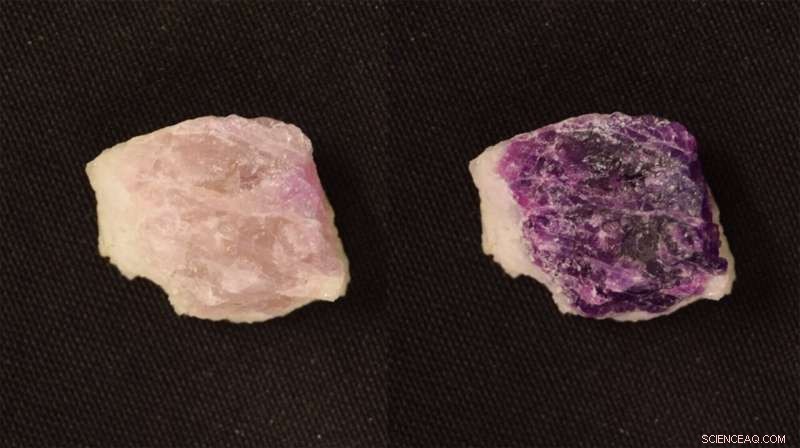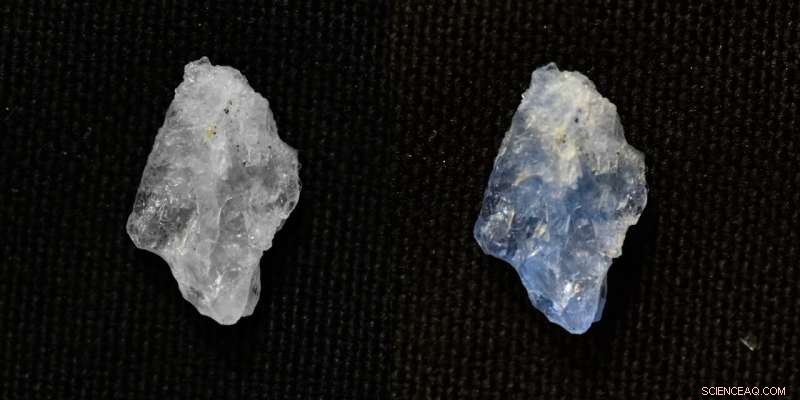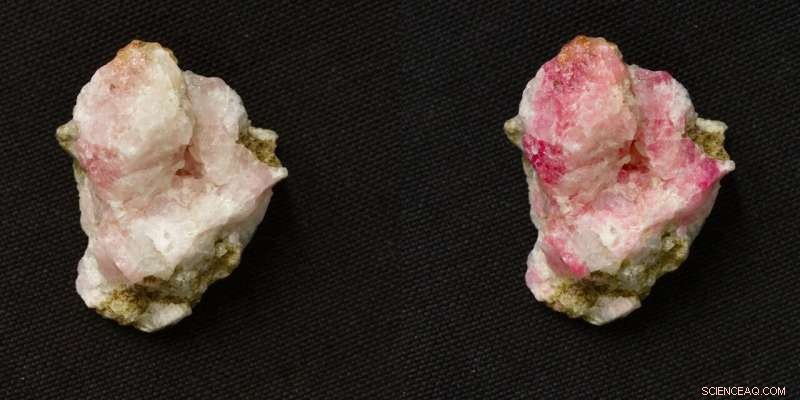
L'hackmanite devient violette sous irradiation UV et la couleur redevient blanche en quelques minutes sous une lumière blanche régulière. Cet échantillon provient du Groenland. Crédit :Mika Lastusaari
En enquêtant sur la hackmanite, les chercheurs ont découvert qu'elle pouvait changer de couleur lors d'une exposition répétée aux rayons UV sans s'user. Les résultats montrent que la hackmanite peu coûteuse, facile à synthétiser, a également une grande durabilité et de multiples applications.
Un groupe de recherche de l'Université de Turku, en Finlande, étudie et développe les propriétés de la hackmanite depuis près d'une décennie. Des applications telles que la surveillance UV personnelle et l'imagerie par rayons X ont été développées sur la base de la capacité de hackmanite à changer de couleur.
L'hackmanite change sa couleur du blanc au violet sous irradiation UV et finit par redevenir blanche si aucun UV n'est présent. Les caractéristiques structurelles permettant de tels changements répétés n'ont jusqu'à présent pas été claires. Aujourd'hui, après avoir étudié trois minéraux naturels :l'hackmanite, la tugtupite et la scapolite, les chercheurs ont trouvé la réponse.
Ces minéraux qui changent de couleur sont des matériaux naturels inorganiques, mais il existe également des composés organiques, des hydrocarbures, qui peuvent changer de couleur de manière réversible en raison de l'exposition aux radiations. Ces hydrocarbures, cependant, ne peuvent changer de couleur que quelques fois avant que leur structure moléculaire ne se décompose. En effet, le changement de couleur implique un changement radical de la structure, et subir ce changement à plusieurs reprises finit par casser la molécule.
"Dans cette recherche, nous avons découvert pour la première fois qu'il y a en fait un changement structurel impliqué dans le processus de changement de couleur. Lorsque la couleur change, les atomes de sodium de la structure s'éloignent relativement de leurs emplacements habituels, puis reviennent. C'est ce qu'on appelle la "respiration structurelle", et elle ne détruit pas la structure même si elle est répétée un grand nombre de fois", rapporte le professeur Mika Lastusaari du département de chimie de l'université de Turku, en Finlande.

La scapolite blanche vire au bleu sous irradiation UV. La coloration et le retour au blanc après le retrait de la source UV ne prennent que quelques secondes, car les atomes de la structure se déplacent sur de courtes distances. La scapolite est un minéral assez commun. Cet échantillon vient d'Afghanistan. Crédit :Sami Vuori
Les chercheurs ont prouvé que la capacité de l'hackmanite à alterner entre les formes blanches et violettes est hautement reproductible
Selon le professeur Lastusaari, la durabilité est due à la forte structure globale en forme de cage tridimensionnelle de ces minéraux, qui est similaire à celle trouvée dans les zéolithes. Dans les détergents, par exemple, la structure en forme de cage permet à la zéolite d'éliminer le magnésium et le calcium de l'eau en les liant étroitement à l'intérieur des pores de la cage.
"In these color-changing minerals, all processes associated with the color change occur inside the pores of the zeolitic cage where the sodium and chlorine atoms reside. That is, the cage-like structure allows atomic movement inside the cage while keeping the cage itself intact. This is why minerals can change color and revert back to their original color practically indefinitely," Doctoral Researcher Sami Vuori explains.
Previously, it has been known that scapolite changes color much faster than hackmanite, whereas tugtupite's changes are much slower.
"Based on the results of this work, we found out that the speed of the color change correlates with the distance that the sodium atoms move. These observations are important for future material development, because now we know what is required from the host structure to allow the control and tailoring of the color change properties," says Doctoral Researcher Hannah Byron.
"There were no characterization methods available for the research on color changing minerals, which is why we have developed new methods by ourselves. However, it is difficult to interpret the results unambiguously based on experimental data alone. In fact, we could not have reached the present conclusions without strong support from theoretical calculations, since only the combination of experimental and computational data shows the whole picture. We owe a great many thanks to our collaborator Professor Tangui Le Bahers and his group, who have developed and advanced suitable computational methods to such detail and accuracy that would not have been possible just a few years ago," says Lastusaari.

Tugtupite is a rare mineral, which turns pink when exposed to UV radiation. The return back to white takes several hours, because it requires large atomic movements. This sample is from Greenland. Credit:Sami Vuori
Hackmanite has amazing potential for applications
The Intelligent Materials Research Group at the Department of Chemistry of the University of Turku, led by Lastusaari, has long conducted pioneering research on materials with light and color-related properties, especially on hackmanite. They are currently exploring numerous applications for hackmanite, such as possibly replacing LEDs and other light bulbs with the natural mineral and using it in X-ray imaging.
One of the most interesting avenues that the researchers are currently exploring is a hackmanite-based dosimeter and passive detectors for the International Space Station, intended to be used to measure the radiation dose uptake of materials during space flights.
"The strength of hackmanite's color depends on how much UV radiation it is exposed to, which means that the material can be used, for example, to determine the UV index of Sun's radiation. The hackmanite that will be tested on the space station will be used in a similar fashion, but this property can also be used in everyday applications. We have for example already developed a mobile phone application for measuring UV radiation that can be used by anyone," explains Sami Vuori.
The paper was published in June in the PNAS journal. Natural mineral hackmanite enables new method of x-ray imaging